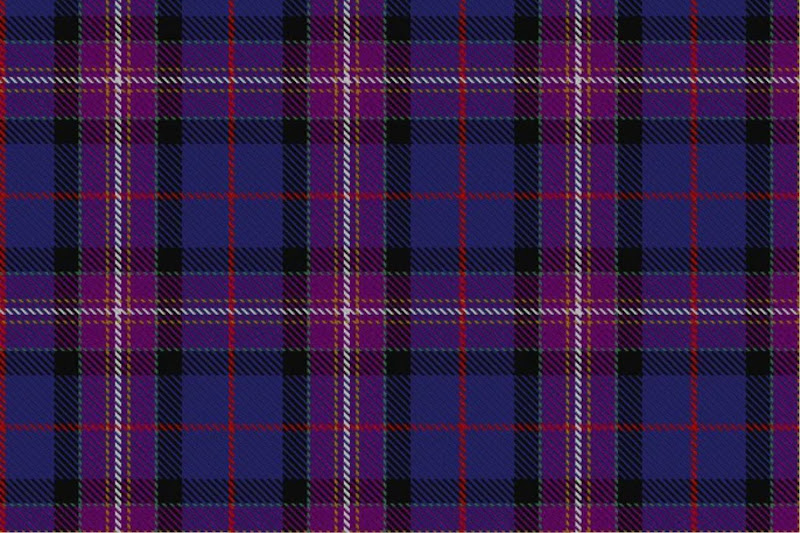FASHION
Deciphering the Meaning Behind Masonic Tartan: What Secrets Lie in Its Threads?

Masonic Tartan, with its mesmerizing patterns and profound symbolism, stands as a testament to the rich heritage and timeless traditions of Freemasonry. Rooted in the rugged landscapes of the Scottish Highlands, this distinctive plaid fabric has woven itself into the very fabric of Masonic culture, embodying the principles of brotherhood, unity, and enlightenment. Across centuries, Masonic Tartan has served as more than just a garment; it is a tangible expression of the values and ideals that Freemasons hold dear. Join us on a journey as we unravel the mysteries hidden within the threads of Masonic Tartan, exploring its origins, symbolism, and enduring significance within the fraternity and beyond.
What is Masonic Tartan?
Masonic Tartan is a distinctive plaid pattern that is closely associated with Freemasonry. Its origins can be traced back to the Scottish Highlands, where tartan patterns have been worn for centuries as a symbol of clan identity and allegiance. The adaptation of these tartans to represent Masonic lodges occurred in the 18th century, with each design holding unique significance to its respective lodge.
Brief history of Masonic Tartan
The history of Masonic Tartan is intertwined with the history of Freemasonry itself. As Freemasonry spread throughout Scotland and beyond, so too did the use of tartan patterns among its members. Over time, these patterns became closely associated with the fraternity, symbolizing the bonds of brotherhood and shared values. The earliest known mention of Masonic Tartan dates back to the 1700s, with references to tartan garments being worn by members of Masonic lodges.
Symbolism and Meaning
Colors used in Masonic Tartan
The colors used in Masonic Tartan are not chosen arbitrarily but are steeped in symbolism. Blue, for example, symbolizes fidelity and loyalty, reflecting the commitment that Freemasons have to their principles and to one another. White represents purity and innocence, while red often symbolizes courage and strength. Other colors, such as black and green, may also be used to convey specific meanings, such as mourning or prosperity.
Symbolic elements incorporated
In addition to colors, Masonic Tartan often incorporates symbolic elements such as the square and compass, which are iconic symbols of Freemasonry. These symbols serve as reminders of the moral and philosophical teachings of the fraternity, encouraging members to live virtuous and honorable lives. Other common symbols found in Masonic Tartan include the sun, moon, and stars, each of which carries its own significance within Masonic symbolism.
The Origins of Masonic Tartan
Historical roots
The roots of Masonic Tartan can be traced back to the emergence of Freemasonry in Scotland during the late medieval period. As the fraternity grew in popularity, so too did the use of tartan patterns among its members. The adoption of these patterns served to further solidify the bonds of brotherhood among Freemasons, providing a visible symbol of their shared identity and values. Over time, Masonic Tartan became an integral part of Masonic regalia, worn by members during formal events and ceremonies.
Evolution over time
Like Freemasonry itself, Masonic Tartan has evolved over time, adapting to changing cultural norms and aesthetic preferences. While traditional tartan patterns remain popular among members of the fraternity, new variations have emerged, reflecting the diversity of the Masonic community. Some lodges have even developed their own unique tartan designs, incorporating elements that are meaningful to their members. Despite these changes, the underlying symbolism and significance of Masonic Tartan have remained constant, serving as a tangible link to the traditions of the past.
Significance in Masonic Culture
Use in rituals and ceremonies
Masonic Tartan plays a significant role in various rituals and ceremonies within Freemasonry. From initiation ceremonies to formal events, the wearing of tartan garments serves as a visible expression of Masonic identity and tradition. In many lodges, tartan is also used as a backdrop during ritualistic proceedings, further emphasizing its importance. For many Freemasons, wearing tartan is not only a symbol of their membership in the fraternity but also a reminder of the values and principles that they strive to uphold.
Connection to Freemasonry principles
The symbolism embedded within Masonic Tartan reflects the core principles of Freemasonry, including brotherly love, relief, and truth. By wearing tartan, members reaffirm their commitment to these principles and to the fraternity as a whole. In this way, Masonic Tartan serves as a tangible reminder of the values that Freemasons strive to uphold, encouraging them to lead lives of integrity and service to others. Through its symbolism and significance, Masonic Tartan helps to strengthen the bonds of brotherhood among Freemasons, fostering a sense of unity and solidarity within the fraternity.
Modern Applications
Contemporary use of Masonic Tartan
In addition to its traditional use within Masonic lodges, Masonic Tartan has found new applications in modern contexts. From fashion accessories to home decor, tartan patterns continue to captivate audiences around the world. Many non-Masonic individuals also choose to incorporate tartan into their attire as a nod to its rich history and cultural significance. In recent years, tartan has experienced a resurgence in popularity, with designers and retailers alike embracing its timeless appeal. Whether worn as a symbol of heritage or as a fashion statement, Masonic Tartan continues to hold a special place in the hearts of Freemasons and non-Masons alike.
Fashion and lifestyle trends
The popularity of tartan patterns extends beyond the Freemasonry community, influencing fashion trends and lifestyle choices. In addition to traditional tartan garments such as kilts and sashes, tartan patterns can be found on everything from handbags to phone cases. Tartan has become a symbol of Scottish heritage and culture, embraced by people around the world as a sign of their connection to the land of the Scots. In recent years, tartan has even been featured on runways and in fashion magazines, cementing its status as a timeless fashion staple. Whether worn casually or formally, tartan adds a touch of elegance and sophistication to any outfit, making it a favorite among fashion-forward individuals of all ages.
Controversies and Misconceptions
Criticisms and debates surrounding Masonic Tartan
Despite its cultural significance, Masonic Tartan has not been immune to controversy. Some critics have questioned its authenticity and appropriateness, leading to debates within the Freemasonry community and beyond. However, proponents of Masonic Tartan argue that its symbolism and tradition outweigh any perceived criticisms. They point to the long history of tartan patterns within Freemasonry as evidence of its legitimacy and significance. While debates may continue to rage on, Masonic Tartan remains an integral part of Masonic culture, cherished by members of the fraternity for its beauty and symbolism.
Dispelling myths and clarifying misconceptions
It is important to address misconceptions surrounding Masonic Tartan and to provide accurate information about its origins and symbolism. By dispelling myths and clarifying misconceptions, we can foster a deeper understanding of this cherished tradition. Education and dialogue are essential in ensuring that Masonic Tartan continues to be valued and respected within the Freemasonry community. Through open and honest communication, we can overcome misunderstandings and promote greater appreciation for the rich heritage of Masonic Tartan.
Exploring Affordable Options: The Appeal of Cheap Kilts
When considering purchasing a kilt, affordability often becomes a crucial factor for many individuals. For those seeking a budget-friendly option, the cheap kilt provides a practical solution without compromising on quality or style. These kilts offer an accessible entry point into the world of Scottish heritage and tradition, allowing enthusiasts to embrace their Celtic roots without breaking the bank. While cheap kilts may be more economical, it’s essential to ensure that they still meet the standards of authenticity and craftsmanship expected of traditional Scottish attire. With careful consideration and research, finding a cheap kilt that strikes the perfect balance between affordability and quality is entirely achievable, offering an accessible avenue for anyone eager to don this iconic garment.
Preservation and Heritage
Efforts to preserve Masonic Tartan tradition
As custodians of Masonic heritage, members of the fraternity have a responsibility to preserve the tradition of Masonic Tartan for future generations. Through initiatives such as archival preservation and educational outreach, efforts are underway to ensure that this tradition endures. By documenting the history of Masonic Tartan and its significance within Freemasonry, we can ensure that its legacy lives on for centuries to come. In addition to preserving existing tartan patterns, some lodges are also working to create new designs that reflect the changing demographics of the Masonic community. These efforts will help to ensure that Masonic Tartan remains a vibrant and relevant part of Masonic culture for generations to come.
Importance of heritage in Freemasonry
Masonic Tartan serves as a tangible link to the rich history and heritage of Freemasonry. By honoring and preserving this tradition, we pay homage to those who came before us and uphold the timeless values of the fraternity. In a rapidly changing world, the preservation of Masonic Tartan reminds us of the importance of preserving our cultural heritage and traditions. By celebrating the past and embracing the future, we can ensure that Freemasonry continues to thrive for generations to come. Through its symbolism and significance, Masonic Tartan helps to unite Freemasons around the world, fostering a sense of brotherhood and camaraderie that transcends borders and boundaries.
Conclusion
In conclusion, Masonic Tartan stands as a symbol of unity, tradition, and brotherhood within the Freemasonry community. Its vibrant colors and intricate patterns tell a story of centuries-old traditions and enduring principles. As we unravel the mysteries hidden within its threads, we gain a deeper appreciation for the heritage and symbolism that define Freemasonry. Masonic Tartan is more than just a piece of fabric – it is a tangible expression of the values and ideals that Freemasons hold dear. By preserving and cherishing this tradition, we ensure that the legacy of Masonic Tartan lives on for generations to come.
FAQs (Frequently Asked Questions)
-
Is Masonic Tartan only worn by Freemasons?
No, while Masonic Tartan is closely associated with Freemasonry, it can be worn by anyone who appreciates its symbolism and aesthetic appeal. Many non-Masonic individuals choose to wear tartan as a fashion statement or as a nod to their Scottish heritage.
-
Can anyone design their own Masonic Tartan?
Designing a new Masonic Tartan typically requires approval from relevant Masonic authorities to ensure that it adheres to established traditions and principles. However, anyone can create their own tartan design for personal or commercial use, though it may not hold the same significance as traditional Masonic Tartans.
-
What is the significance of the square and compass in Masonic Tartan?
The square and compass are iconic symbols of Freemasonry, representing moral values and principles upheld by members of the fraternity. When incorporated into Masonic Tartan, these symbols serve as a reminder of the teachings of Freemasonry and the bonds of brotherhood shared by its members.
-
Are there different variations of Masonic Tartan?
Yes, there are numerous variations of Masonic Tartan, each with its own unique colors and patterns. These variations often reflect the specific traditions and symbolism of individual Masonic lodges or regions. Additionally, new variations of Masonic Tartan may be created over time to commemorate special events or occasions within the fraternity.
-
How can I learn more about the history of Masonic Tartan?
There are many resources available for those interested in learning more about the history and significance of Masonic Tartan. Books, websites, and educational materials produced by Masonic organizations are excellent sources of information. Additionally, individuals may consider reaching out to local Masonic lodges or museums for further insight into this fascinating aspect of Masonic culture.







